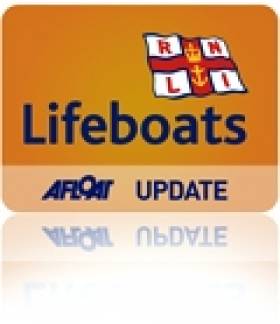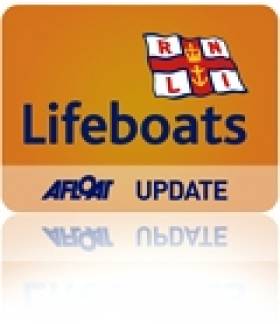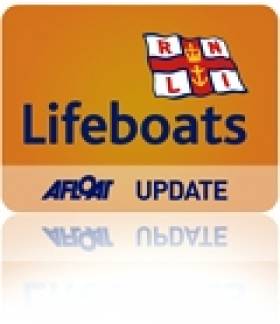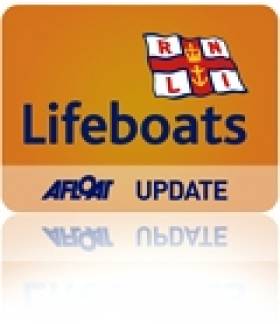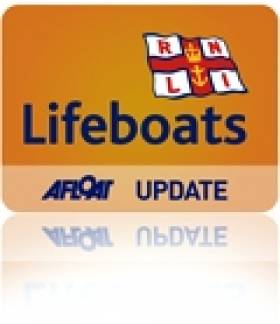Displaying items by tag: Lifeboats
Lough Derg RNLI Treasurer Hands Over Reins
#RNLI - Lough Derg RNLI in Tipperary had a celebration for Nick Theato earlier this month as he handed over the role of treasurer to Caleb Clarke.
On Thursday 14 April, Theato brought his wife Mary and three of his five children - Barry (home from Australia), Anne and Paul (home from the UK) - down to the station to meet crew and members of the operations and fundraising committees.
Nick Theato, who has served as honorary treasurer for the Nenagh RNLI Fundraising Branch for the past 15 years and for the Lough Derg RNLI since it came on service 10 years ago, is handing over treasurer duties to the capable care of Caleb Clarke, but is remaining on the fundraising committee.
Lough Derg RNLI lifeboat operations manager Pat Garland introduced everyone and Niamh McCutcheon, chair of the Nenagh RNLI Fundraising Branch, presented Theato with a certificate of thanks on behalf of the RNLI. Previously in 2010 he received a silver medal for voluntary service to the RNLI.
Theato’s good friend Pat Kelly - fellow sailor, lifeboat administrative officer for Lough Derg RNLI and secretary to the Nenagh Fundraising Committee - said that "after Mary and his children, Nick’s great love is his boat Bo-Bo".
On behalf of Lough Derg RNLI, Kelly presented Theato with a picture of Bo-Bo by artist Clare Hartigan. Nick Theato served in the Royal Navy for many years, and following his retirement back to Ireland, sailed on Lough Derg for many more.
He shared a story of his early years in the navy and of an incident at the outset of his career, which secured his respect for the water ever since. He spoke of his love of Lough Derg and its beauty, but added that he was "well aware of its dangers, even for a lifeboat".
Sligo Bay RNLI Readies To Give It Some Welly This Mayday
#RNLIMayDay - Sligo Bay RNLI in Rosses Point is counting down this week to Mayday, the charity’s annual national fundraising campaign in Ireland.
Now in its second year and running nationwide, from this Wednesday 1 to Bank Holiday Monday 6 May the RNLI is asking the public to 'give it some welly' and help its volunteers to continue to save lives at sea.
Encouraging the people of Sligo to support their local lifeboat station this week is one man who experienced first-hand the lifesaving work of the RNLI volunteers based in Rosses Point, when he was rescued in 2011.
"I guess it is always nice to know the orange boat will be coming up the bay looking for you if you get into difficulty," he said, "so remember to call as soon as you know you are in trouble."
With a fun theme in mind, the Mayday appeal is calling on people to lend their support by either purchasing a special RNLI Mayday yellow welly key ring which will be on sale for €2 in various schools in Sligo during the campaign, or by organising their own yellow welly fundraising event.
The yellow welly is an essential piece of the RNLI volunteer lifeboat crew member’s kit. Waterproof with steel-capped toes, the specially designed boots keep the volunteer crew’s feet warm and dry while also protecting them in dangerous conditions on deck.
During gale force winds, rain and ice, keeping a sure footing can literally mean the difference between life and death for volunteers. A pair of yellow wellies for crew members costs €50.
The public can also join in the social media campaign and help the RNLI raise awareness of its lifesaving work this Mayday.
All you have to do is take a photo of yourself holding an RNLI Mayday yellow welly key ring and tweet the phrase ‘I am giving it some welly for the RNLI this Mayday’ including the hashtag #RNLIMAYDAY and mentioning @RNLI.
For more information on how you can get involved or where you can purchase a key ring, log on to rnli.org/mayday
First Outing for Skerries RNLI's New Lifeboat
#RNLI - Skerries RNLI recorded its first service by its new inshore lifeboat on Sunday afternoon (21 April). SEE VIDEO BELOW
The North Co Dublin lifeboat station's volunteer crew was requested to launch following a report that a vessel was adrift off Bettystown beach.
Crew members, alerted by their pagers, launched their new Atlantic 85 lifeboat Louis Simson within 10 minutes.
It was quickly established that the owner of the vessel was on shore. With the potential for the personal water craft (PWC) to pose a danger, the decision was made to locate it and return it to the beach.
Once on scene, a volunteer crew member was put on board the PWC and brought the vessel safely to shore.
Speaking following the callout, Skerries RNLI volunteer crew member Emma Wilson said: "The visibility was good today, but it was something quite small we were looking for, so being able to have an extra crew member on board our new lifeboat really made a difference during the search."
Busy Saturday for RNLI on Lough Derg
#RNLI - Lough Derg RNLI launched twice yesterday (21 April) on consecutive callouts to a vessel grounded at the Corrakeen Islands and a sinking cruiser at the northern end of the lake.
Around 3.45pm yesterday, Valentia Coast Guard requested the launch of the Lough Derg RNLI lifeboat to assist three people on board their 20ft cruiser after their engine failed and were pushed on to rocks by the Corrakeen Islands in Dromineer Bay.
Helm Eleanor Hooker with Ger Egan and Tom Dunne set out in winds blowing south westerly, force 3 and gusting 5, and the lifeboat was alongside within half an hour of launch.
The two adults and a young child on board were unharmed but extremely anxious. They had dropped anchor to prevent further grounding and breakage.
An RNLI crew member was transferred to their boat to assess for damage and, very quickly - once it was established that the vessel was not holed - set up for a tow, weighed anchor and the lifeboat took them off the rocks and out into safe water.
The lifeboat then towed the boat with her crew (and the RNLI volunteer still on board) to Dromineer Harbour, where RNLI shore crew were waiting to take lines and help.
Lough Derg RNLI crew member Ger Egan advised that said anyone taking their boat afloat after the long winter should "make sure that their engines are fully serviced and make sure to use new fresh fuel".
Later that afternoon the lifeboat launched again to assist two people who had taken to their liferaft as their cruiser was sinking.
The exact location of the 28f cruiser was not certain, but once the lifeboat crew were informed that the cruiser had set out from Terryglass at the northern end of the lake, an half hour earlier they were able to accurately estimate the liferaft’s current location.
At 5.50pm the lifeboat launched with helm Eleanor Hooker, Peter Clake and David Moore on board. Winds were south westerly, force 4, gusting 6.
The lifeboat located the cruiser and the liferaft north of Coolbawn, south of Gortmore, on the eastern shore of Lough Derg, and was alongside by 6.15pm, The two people on board were unharmed, but the skipper was greatly distressed.
He had inadvertently veered off course and had glanced off a rock and holed his boat. A passing 18ft speedboat with two people on board also came alongside and gave assistance.
Two lifeboat crew members helped the people from the liferaft and onto the speedboat, which had a canopy and offered shelter from the wind. They gathered the liferaft and its contents into the cruiser cabin and, as the cruiser was rapidly taking water, they weighed anchor so that the lifeboat could beach the vessel and reduce risk of further damage.
Once beached, the lifeboat crew dropped anchor once more, and especially as the winds were forecast to get up in the night. There was no evidence of fuel leakage and arrangements were made for the vessel to assessed and recovered this morning.
The lifeboat and the speedboat, with the two casualties on board and under cover, then made way to Garrykennedy where friends were waiting to look after them.
Eleanor Hooker thanked Cillian Boyle, the helm of the speedboat, for his kind assistance and commended her crew for their "kind consideration of the casualties and their calm professionalism in dealing with the fraught situation".
Aran Islands RNLI Rescue Fishermen in Galway Bay
#RNLI - Aran Islands RNLI in Galway Bay assisted six fishermen from a 24m trawler yesterday Thursday 18 April.
The volunteer lifeboat crew launched their all-weather lifeboat at 4.20pm following a report that a fishing vessel, the Archangel, with six crew on board had got into difficulty and broken down one mile north west of Inishmore.
There was a six-metre swell at the time with a force seven to eight wind.
The lifeboat crew under coxswain John O’Donnell arrived on scene accompanied in the air by Irish Coast Guard helicopter Rescue 115 - the subject of its own documentary TV series currently showing on RTÉ One - and established a tow line removing the vessel from any immediate danger.
The trawler was then towed back to Rossaveal in Connemara.
Speaking following the call-out, Aran Islands RNLI lifeboat operations manager Michael Hernon said: "Thanks to the speed and efficiency of the crew in launching the lifeboat, we were able to arrive on scene in good time to assist the fishermen and successfully tow the trawler safely to shore."
Douglas RNLI Brings Shannon Class To Irish Sea
#RNLI - The Irish Sea will soon have one of the most advanced lifeboats in service as Douglas RNLI in the Isle of Man has been earmarked to receive one of the new Shannon class.
The new design is 50% faster than the lifeboat it will replace, ensuring that those in need are reached even faster.
The RNLI plans to replace the Tyne class lifeboat at Douglas in 2016, which is reaching the end of its planned 25-year life span. The new lifeboat will cost £2 million (€2.32 million) and the RNLI is currently working to identify whether the funding for the new lifeboat can be raised from legacy gifts or whether fundraising activity is needed. The RNLI will announce this once the funding strategy has been identified.
The Shannon is the first modern RNLI all-weather lifeboat to operate with water jets, not propellers. Capable of 25 knots, the Shannon is 50% faster than the classes it has been designed to replace, which have a lower maximum speed of 17 knots.
The Shannon class will also improve safety for the charity’s volunteer crews, thanks to its shock absorbing seats and on-board computer system, which allows the crews to operate and monitor the lifeboat from the safety of their seats.
Michael Vlasto, RNLI operations director said of the new vessel: "I have had the privilege of being involved with the RNLI for over 38 years. In that time I have witnessed great advances in the charity’s lifeboats and seen many new vessels arrive on station. However, I have never seen our volunteer crews quite as excited as they are about the Shannon.
"This all-weather lifeboat is half as fast again as the lifeboats it has been designed to replace and using water jet propulsion, the manoeuvrability is exceptional. Most importantly though, the Shannon has been carefully developed with the safety of the volunteer crews at the very heart of the design, allowing them to shave life-saving moments off the time it takes to reach those in trouble at sea."
Some of the RNLI Douglas volunteer crew were given the opportunity to experience the Shannon first-hand with a trip around Douglas Bay last weekend as the prototype lifeboat visited the island as part of sea trials that began in January, as previously reported on Afloat.ie.
Afterwards, Douglas coxswain Neal Corran was asked for his immediate thoughts on the new lifeboat. "I was impressed with the boat’s speed and manoeuvrability and look forward to Douglas receiving theirs when it becomes available," he said.
The Shannon has been developed by the RNLI’s in-house team of naval architects, marine engineers and operators - including Irish naval architect Peter Eyre – to replace the majority of Mersey and some remaining Tyne class lifeboats as they reach the end of their operational life (subject to the RNLI’s five-year rolling review of lifesaving assets).
Once the Shannon is rolled out across the UK and Ireland, this class of lifeboat will make up a third of the RNLI all-weather lifeboat fleet, at which point the RNLI will have reached its aim of a 25 knot all-weather lifeboat fleet.
The majority of the 50-plus Shannon class lifeboats to be stationed throughout the UK and Ireland will be built at the RNLI’s new all-weather Lifeboat Centre in Poole, which is currently under construction. Bringing all-weather lifeboat production in-house will save the charity £3.7m annually – the equivalent of 2.5 Shannon class lifeboats.
RNLI Crews Assist Windsurfer, Stricken Fishing Boat in Co Down
#RNLI - Portaferry RNLI rescued a windsurfer who got into difficulty off the Co Down coast yesterday (16 April).
The volunteer crew launched their inshore lifeboat before 5pm yesterday evening to go the aid of the injured windsurfer reported to be in the area of Pig Island, a small island in Strangford Lough close to Newtownards Sailing Club.
The weather at the time was described as blowing slight to moderate winds with good visibility.
The crew was on scene at 5.15pm where they found the man on Pig Island accompanied by two other men. The windsurfer, who was suffering from a shoulder injury, was transferred to the lifeboat and made comfortable before being taken to the sailing club, where he was then transferred into the care of the coastguard and passed to the ambulance service to be taken to hospital.
Speaking after the rescue, Portaferry RNLI lifeboat operations manager Brian Bailie said: "As the charity that saves lives at sea, we will always respond to any call for help where someone is in danger.
"Strangford Lough is a popular destination for a wide range of water sport enthusiasts and it is important that they take all necessary precautions when using the lough.
"As we are all aware, accidents can and do happen and it is at such times that the work carried out by the volunteer crews of the RNLI is so important."
Elsewhere in Co Down yesterday, Bangor and Donaghadee RNLI assisted a fisherman whose 28ft commercial fishing boat experienced engine failure.
The crew quickly located the disabled boat one mile west of the Copeland Islands at the mouth of Belfast Lough yesterday morning after 11.15am.
With the vessel drifting closer to the island shores and the wind gusting gale force eight, a tow line was quickly rigged and passed to the fishing boat. Bangor RNLI was escorted by Donaghadee RNLI's all-weather lifeboat as it towed the fishing vessel to the safety of Bangor Harbour.
Bangor RNLI volunteer helm Peter Scott, who was involved in this rescue, said: "Engine failure close to shore could lead to a life threatening situation. We always urge everyone going to sea to make sure their electrical systems and engine are well maintained and in good working order. A good anchor and chain should always be carried as part of essential safety equipment.
"We are glad the skipper of this vessel is now safely ashore," he added.
Lifeboat Roundup: Windsurfers Rescued In Waterford; Boats Aground in Wexford, Lough Erne
#RNLI - The Dunmore East RNLI lifeboat was tasked yesterday (7 April) to assist two windsurfers in difficulty near Duncannon in Waterford Harbour.
In rough conditions yesterday afternoon, with south-east winds force 6/7 blowing, coxswain Pauly Daniels reached the casualties' position within 30 minutes.
By this stage one of the surfers had made it ashore safely at Duncannon. The Dunmore East lifeboat quickly located the other windsurfer a quarter of a mile north of Duncannon. The casualty was safely recovered from the water and landed ashore nearby.
Neither casualty was injured and did not need medical attention.
Nearby in Wexford, five teenagers were rescued from a small speedboat after it suffered engine failure and ran aground on the River Slaney around 1.20pm yesterday.
According to Lorraine Galvin, volunteer press officer at Wexford RNLI, the teens' "fast call for help to the coastguard greatly helped in ensuring their speedy rescue in cold, rough weather conditions".
At the time of the rescue there were wind speeds of force 5 south-easterly and a rough sea state. All of the passengers were starting to suffer from the cold and were treated for mild hypothermia.
Meanwhile, on Upper Lough Erne last Friday the volunteer lifeboat at Enniskillen RNLI (Carrybridge) launched to reports of a vessel that had run aground.
The RNLI lifeboat and rescue water craft were both launched and proceeded to the casualty's last known location 2.5 miles upstream from Carrybridge at Innishmore viaduct.
On route to the scene at the Innishmore viaduct, the volunteer crew got further information that the vessel had managed to refloat and was currently at Killygowan Island.
A full inspection was carried out and none of the crew on the casualty vessel were found to be in need of medical attention.
It was decided with the owner's permission that the volunteer crew would escort their vessel back to Carrybridge with the lifeboat leading and rescue water craft following as the navigation lights were not working.
Butcher Couple Eschews Anniversary Gifts for RNLI Donation
#RNLI - Rather than accept gifts for their 50th wedding anniversary, a Portstweart couple have asked their family and friends to make donations to Portrush RNLI.
As the Coleraine Times reports, Ewart Toms and his wife - who are well known butchers in the area - raised £500 for the RNLI which they were more than happy to hand over to lifeboat station volunteers at Portrush.
They said: “We wanted to mark this special occasion in our lives, by making a donation to a cause close to our hearts, and to the volunteers who risk their lives to save others.”
The Coleraine Times has more on the story HERE.
Enniskillen RNLI Assist Sinking Vessel on Lough Erne
#RNLI - Enniskillen RNLI at Carrybridge was tasked on Tuesday afternoon (2 April) by Belfast Coastguard to reports of a boat taking on water and sinking on Lough Erne.
The lifeboat travelled 4km towards Enniskillen to the last known position of the sinking vessel. On arrival at the scene, the lifeboat crew saw that the occupants of the vessel were on land and that the vessel had been secured to a tree on the bank, though it was still taking on water.
The voluntary crew checked that everyone was present and there were no injuries. Once this was established, the lifeboat crew assessed the casualty vessel and found that the bung was missing.
They located two corks and these were made into a temporary bung. A salvage pump was set up and the water was removed.
The owner of the vessel was contacted and came to the scene. The vessel was judged by the RNLI crew to be capable of making the short distance back to Carrybridge where it was recovered onto a trailer.



























